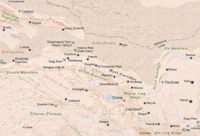
Photo from wikipedia
Abstract The Hexi Corridor Desert is in Gansu Province, northwestern China. The material provenance of desert formation and development is the primary factor of aeolian geomorphology, and it is still… Click to show full abstract
Abstract The Hexi Corridor Desert is in Gansu Province, northwestern China. The material provenance of desert formation and development is the primary factor of aeolian geomorphology, and it is still not fully understood in the Hexi Corridor Desert. To identify sources of aeolian sand in the formation of dunes in the Hexi Corridor Desert, we investigated 12 sites and collected 70 samples from the dune surface. This study used ratios between Na2O/Al2O3 versus K2O/Al2O3 and SiO2/Al2O3, Ba/Sr versus Rb/Sr and Rb/Sr versus Ce/Sr as well as CaO and Cl composition to identify sediment provenance. CaO was enriched relative to the composition of the upper continental crust (UCC), consistent with a previous study conducted in the Taklamakan and Badain Jaran deserts on adjacent fluvial, lacustrine and gravel deserts, but it differed from one study conducted in the Kumtagh and Tengger deserts. Cl concentrations differed in lacustrine and sand sediments, being higher in lacustrine sediments, followed by sand sediment. Sand sample geochemistry was similar throughout, indicating that sources of sand formation were also similar, which was confirmed by the multidimensional scaling (MDS) and principal component analysis (PCA) methods. Additionally, based on regional topography, the Hexi Corridor acts as a sediment sink not only for sediment from the Qilian Mountains but also for sediment from the Beishan Mountains. The MDS and PCA approaches also indicated that sediment provenance was similar in the Hexi Corridor and the Tengger, Badain Jaran and Kumtagh deserts. Therefore, it can be concluded that dry fluvial deposits, alluvial deposits and lacustrine sediments that combined comprised sand dune provenance were the sources of sand in the Hexi Corridor Desert, and these deposits derived from the Qilian Mountains in the southwest and the Beishan Mountains in the north through alluvial processes.
Journal Title: CATENA
Year Published: 2020
Link to full text (if available)
Share on Social Media: Sign Up to like & get
recommendations!